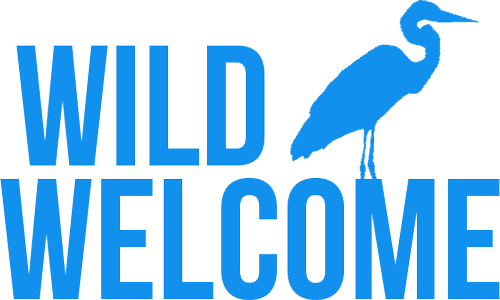Discovering an injured or oiled seabird can be alarming. If the bird is flying well, it likely cannot be captured for treatment. However, if it can only fly short distances, a trained wildlife rescuer may be able to help.
Only adults should rescue wildlife. Before rescuing wildlife, seek guidance from a licensed wildlife rehabilitator.
Step 1: Assess the Situation
- Observe from a Distance: Before approaching, watch the animal quietly. Some birds may simply be resting. However, if the bird is pelagic (meaning it spends most of its life in the water) being on the beach is a sign of distress. Pelagic birds include: loons, grebes, ocean ducks, and murres are examples of pelagic bird species.
- Check for Injuries: Signs that the animal needs help include visible wounds, bleeding, broken limbs, or signs of illness such as lethargy or vomiting. If the animal shows any of these signs, contact your local wildlife rehabilitation center immediately. If a seabird appears wet or its feathers look unusually flat or dull, it may have lost its waterproofing—a serious condition that requires urgent care.
ATTENTION: Seabirds can have Highly Pathogenic Avian Influenza (HPAI). Signs of illness include: head bobbing, balance problems, walking in circles, seizures, and trouble breathing (respiratory issues). These animals should not be touched and should be reported for assistance from a trained professional. For protective actions for health please see the CDC website.
Step 2: Identify the Species and Age
- Pelagic or non-pelagic: some seabird species spend time on land (non-pelagic) and those that do not (pelagic). Knowing the difference can help determine whether an animal need assistance or not.
Step 3: When to Intervene
- Oiled Animals: Any amount of oil on a bird means it needs immediate help. Oil disrupts the bird’s waterproofing, preventing it from regulating its body temperature.
- Entanglement: If a bird is hooked or entangled in fishing line or other debris, it needs professional care. Do not attempt to remove hooks or line yourself, as this can cause further injury. Instead, contact a trained wildlife rehabilitator or rescue organization for assistance.
- Broken Limbs: Wing injuries may be indicated by a drooping wing, a wing dragging on the ground, or wings that appear uneven or asymmetrical. Leg injuries are often signaled by limping, difficulty walking, or trouble standing.
- Lethargy: A beached and lethargic bird may be suffering from exhaustion or starvation. If the bird shows signs of neurological issues or symptoms consistent with Avian Influenza, do not touch it. Always contact a trained wildlife professional to handle lethargic or unresponsive animals safely.
- Birds that do not fly away: Generally speaking, if you can walk right up to a seabird and it does not fly away you should call a trained wildlife professional.
- Juvenile animals: Some young birds—such as Black-crowned Night-Herons and Great Egrets—may appear abandoned when they leave the nest. This is often a natural part of their development. If you encounter a juvenile bird, take a photo or video and contact a local wildlife rehabilitator. They can help determine whether the bird is behaving normally or needs assistance.
Step 4: How to Help Safely
Call a professional or contact a Wildlife Rehabilitation Center – Reach out to your local wildlife rescue for instructions on what to do next. They can assess whether the animal requires immediate care. Many wildlife centers have help hotlines that will provide specific information based on your location and the species. Many states also have wildlife agencies that provide guidance.
Extra Tips
- Keep Pets on a leash: Unleashed dogs on the beach can disturb resting and feeding seabirds, causing stress and interrupting vital behaviors.
- Leave Natural Areas Undisturbed: Many shorebirds nest directly in the sand above the high tide line, making their nests easy to overlook. Always stay on designated paths and observe posted signs that protect sensitive habitats.
- Observe Quietly: If you're unsure whether a juvenile bird is truly orphaned, watch from a hidden spot for at least an hour to see if the parents return.
- Secure your food: If you're enjoying a beach picnic, store your food in hard-sided, sealed containers. This helps prevent curious seabirds from scavenging and forming unhealthy habits—or getting sick from human food.
By understanding and respecting the natural behaviors of wildlife, you help ensure their safety and well-being—making it more likely they can recover and return to their natural habitat.


